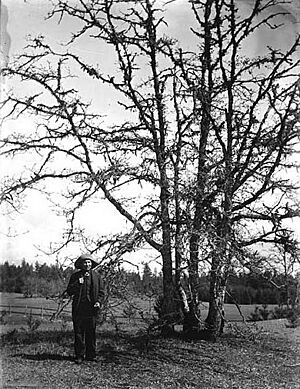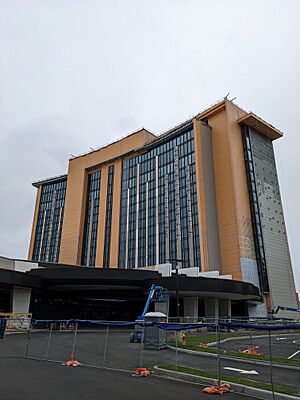Muckleshoot facts for kids
Quick facts for kids
Muckleshoot Indian Tribe
bəqəlšuɬ
|
|
|---|---|
|
Flag
|
|

Location of the Muckleshoot Reservation
|
|
| Languages | Lushootseed, English |
| Ethnic groups |
|
| Demonym(s) | Muckleshoot |
| Type | Federally-recognized tribe |
| Legislature | Muckleshoot Tribal Council |
| Establishment | |
| December 26, 1854 | |
| 1855 | |
|
• Muckleshoot Reservation established
|
January 20, 1857 |
|
• Constitution ratified
|
October 21, 1936 |
|
Website
https://www.muckleshoot.nsn.us/ |
|
The Muckleshoot Indian Tribe (pronounced MUH-kl-shoot) is a Native American tribe. It is officially recognized by the United States government. The tribe is located in Auburn, Washington.
The Muckleshoot Tribe manages the Muckleshoot Reservation. Its members are descendants of several groups. These include the Duwamish, Stkamish, Smulkamish, Skopamish, Yilalkoamish, and Upper Puyallup peoples. The tribe was formally set up in 1936. This happened after the Indian Reorganization Act of 1934. However, its roots go back to the creation of the Muckleshoot Reservation in 1874. It also connects to the treaties of Medicine Creek (1854) and Point Elliott (1855).
Contents
What Does "Muckleshoot" Mean?
The name "Muckleshoot" comes from the Lushootseed language. It is an English version of the word bəqəlšuɬ.
This word, bəqəlšuɬ, first referred to a prairie. This prairie was located between the White and Green rivers. It was not originally a name for the people living there. Before the Muckleshoot reservation was created, local Indigenous groups were called "Green River Indians" or "White River Indians." They were also known by their village names, like Skopamish.
The name "Muckleshoot" was first written down by George Gibbs between 1853 and 1856. He noted "Mukl-shootl" as a "prairie... U.S. Military Station." Over time, the name changed. It went from meaning a prairie to meaning a military outpost on that prairie.
When the reservation was set up at the fort, it took the prairie's name. Later, the name was used for the Native Americans living on the reservation. The first time "Muckleshoot" was used to describe a group of people was in 1864.
A Look Back: Muckleshoot History
The Muckleshoot Indian Tribe carries on the traditions of several groups. These groups lived along the Duwamish River's watershed. They also lived in parts of the upper Puyallup River's watershed. These groups included:
- Duwamish
- Stkamish
- Smulkamish
- Skopamish: This name was used for all peoples living along the Green River. It included eight to ten independent villages, such as the Yilalkoamish.
- Upper Puyallup peoples
- Tkwakwamish
How the Muckleshoot Reservation Began
The Muckleshoot Indian Tribe's story starts with two treaties. These were the 1854 Treaty of Medicine Creek and the 1855 Treaty of Point Elliott. The Stkamish, Skopamish, and Smulkamish groups were mentioned in the Treaty of Point Elliott. However, they did not sign it directly.
The governor of Washington Territory, Isaac Stevens, thought these groups were under the control of the Duwamish and Seattle. Governor Stevens wanted to change how Indigenous groups were organized. He aimed to appoint single "chiefs" to lead entire groups. This was different from their traditional ways. Seattle was named a "head chief" for a Duwamish Tribe. This group included all peoples along the Duwamish watershed, like those on the Green and White rivers.
Because of this, the Muckleshoot Tribe has sometimes said they have both treaty and non-treaty status. The Muckleshoot Reservation is on land given up by the Treaty of Point Elliott. But its creation was decided by the Treaty of Medicine Creek. This added to the confusion.
Many people were unhappy with these treaties. This led to the Puget Sound War in 1855. The groups that would become the Muckleshoot joined the war against the American government. After the war, during the Fox Island Council, Governor Stevens agreed to create a new reservation. This was for groups who had not received one from earlier treaties. At Fox Island, Stevens agreed that a reservation would be made. It would include all the lands between the White and Green rivers, including Muckleshoot Prairie.
The Muckleshoot Reservation was officially created on January 20, 1857. This was done by an order from U.S. president Franklin Pierce. However, the reservation did not include all the land promised at the Fox Island Council. This included important fishing and village sites. The reservation was later made larger in 1874 by president Ulysses S. Grant.
Forming the Muckleshoot Indian Tribe
In 1934, the Indian Reorganization Act was passed. This law allowed Native Americans on reservations to create their own governments. The people of the Muckleshoot Reservation voted to form the Muckleshoot Indian Tribe. In 1936, they wrote a constitution and rules for their government. Around 1937, the Muckleshoot Tribe had 194 official members.
Protecting Treaty Rights
The Muckleshoot Tribe faced challenges in getting their land claims recognized. In the case of Duwamish Indians v. United States, their claims were denied. This was because there was no treaty specifically with the "Muckleshoot." However, in 1959, the Indian Claims Commission found that the Muckleshoot's ancestors had owned about 101,620 acres of land. This land was valued at $86,377. On March 8, 1959, the Commission ordered the United States to pay this amount to the Muckleshoot Tribe.
After World War II, the area around Auburn became more industrial. The population grew quickly, and many suburbs developed. These changes put pressure on the Muckleshoot and their reservation lands. Many private landowners tried to stop them from fishing and hunting in their traditional areas.
In the 1960s and 1970s, the Muckleshoot protested to protect their environment. These protests were known as the Fish Wars. They aimed to keep Muckleshoot fishing rights in nearby rivers. These rivers were not inside the official reservation. State authorities tried to control their fishing outside the reservation.
In the Boldt Decision, a federal court supported the Muckleshoot's rights. It upheld the right of the Muckleshoot and other Treaty peoples to fish and hunt in their traditional territories. The court ruled that Native Americans had rights to half the fish caught in their traditional areas. The Muckleshoot were named co-managers of the King County watershed. This gave them control over fishing and hunting in their "Usual and Accustomed" historical grounds.
This decision helped the tribe's economy. However, the Muckleshoot soon faced a big drop in salmon numbers. This was due to pollution and development from cities and industries. Dams on rivers also reduced the fish that could swim upstream to lay eggs. The Muckleshoot continue to work to protect the salmon runs. They have also found other ways to improve their economy.
Muckleshoot Reservation
Most Muckleshoot citizens live on or near the Muckleshoot Reservation. The reservation is about 15.871 square kilometers (6.128 square miles) in size. It is located between the White and Green rivers on Muckleshoot Prairie. This is southeast of Auburn, Washington.
The reservation is in parts of King and Pierce counties. In 1975, about 1,201 acres of the land on the reservation was held in trust for the tribe.

On November 6, 2013, the Muckleshoot Tribe bought 150 square miles of forest in Washington state. This was added to their landholdings.
Muckleshoot Population
The Muckleshoot Tribe has a population of over 3,000 people. This makes the Muckleshoot one of the largest Native American tribes in Washington State. The 2000 census reported 3,606 residents on reservation land. About 28.65 percent of these residents reported only Native American heritage.
Muckleshoot Culture
The Muckleshoot people speak the southern dialect of Lushootseed. This dialect is called Whulshootseed. The specific type of Southern Lushootseed spoken at Muckleshoot is called bəqəlšuɬucid. Most people now speak English. However, the tribe is working to bring their language back. Muckleshoot citizens Earnie Barr, Eva Jerry, Bertha McJoe, Bernice Tanewasha, and Ellen Williams helped create a written form for Lushootseed.
The Muckleshoot Tribe holds Skopabsh Days every August. This is a three-day festival. It features traditional arts, crafts, cooking, and clothing. Also, every July, the Muckleshoot Tribe hosts the Muckleshoot Sobriety Powwow.
In the First Salmon Ceremony, the whole community shares the meat of a Spring Chinook salmon. They return its bones and ashes to the river where it was caught. This is so the salmon can tell other fish how well it was received. They believe the fish will come alive again as part of new salmon generations.
Economy and Services
Most Muckleshoot citizens work in Auburn, a nearby city. Many also work for the tribal government. Others work in fishing, logging, or farming on the reservation. The tribe manages fisheries and fish hatcheries. They also have a community center, housing, a library, and a medical and dental clinic. They offer an educational training program and a youth group program. The tribe employs 1,200 people. This makes it the second-largest employer in southern King County.
Economic Growth
The tribe won money from Puget Sound Power & Light. This was for the long-term effects of dam building. They also received money from the state government. This was for sales taxes charged on the reservation. They used this money, plus earnings from a bingo hall, to buy more land. By 1995, they had bought over 800 acres on the reservation.
In 2006, the tribe made a $42 million agreement with the Seattle City Council. This was for protecting the Cedar River.
The Muckleshoot Tribe bought the Salish Lodge at Snoqualmie Falls in 2007 for $62.5 million. They sold it to the Snoqualmie Tribe for $125 million in 2019.
Since 2019, the tribe has made deals with sports teams. They have sponsorship agreements with the Seattle Seahawks and Seattle Mariners. These include naming rights and jersey sponsorships. The Seattle Kraken hockey team started wearing a Muckleshoot Tribe logo patch in the 2023–24 NHL season. This is believed to be the first time a tribe, not just a casino, has sponsored a major American sports team.
Muckleshoot Casino
The Muckleshoot Tribe opened the Muckleshoot Casino in April 1995. This happened after changes to Native American gaming laws. The casino and bingo hall had a tropical theme. It also included an area for horse racing betting. Since then, the casino has been made larger four times. The White River Amphitheatre was built by the tribe next to the casino. It opened in June 2003. Money from these businesses helped build a new tribal medical center. It also funded tribal offices and a new Indian Shaker church in the early 2000s. Twenty percent of all money from tribal gaming goes to education.
The Muckleshoot Casino was expanded in January 2024. An 18-story hotel with 401 rooms was opened. The casino itself was made larger to 300,000 square feet. A parking garage at the site opened in 2021.
Getting Around: Transportation
Since 2017, Muckleshoot Tribal Transit has offered free bus service on the reservation. This transit service gets money from the Federal Transit Administration and the Bureau of Indian Affairs.
Learning and Education
Education for the tribe is provided by Muckleshoot Child Care, Muckleshoot Tribal Schools, and the Muckleshoot Tribal College. Muckleshoot Tribal Schools started in 1984. They offer education that focuses on Indigenous history, art, dance, and culture, as well as language. In 1997, MTS began offering all high-school grades. A modern school for kindergarten through 12th grade opened in 2009. It provides academic and cultural learning, plus modern technology. Students can earn an associate's degree at Muckleshoot Tribal College.






